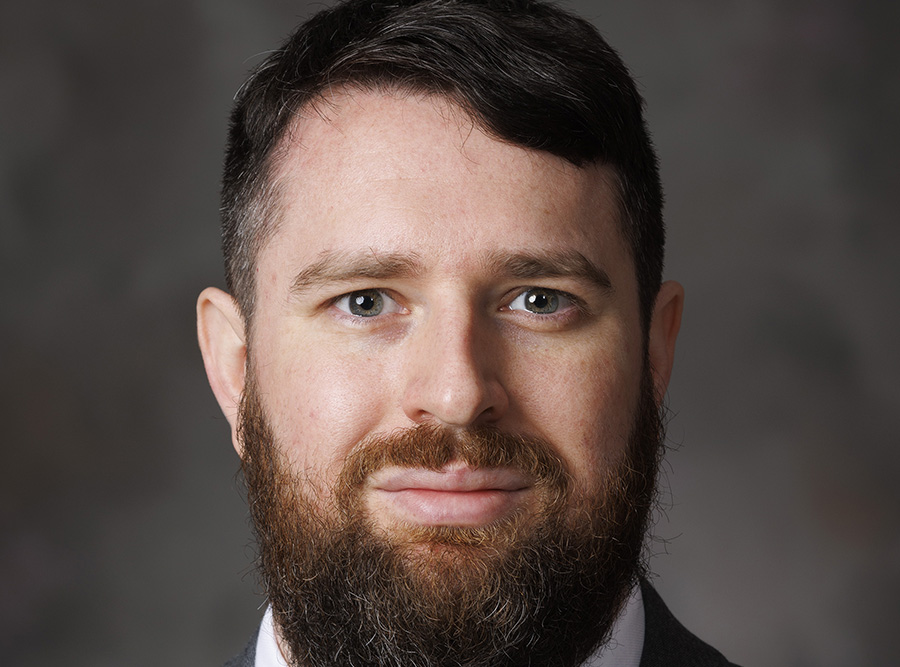Calendar Icon
Jan 10, 2022
Person Bust Icon
By Karl Vogel
![]() RSS
Submit a Story
RSS
Submit a Story

RELATED LINKS
Keegan Moore, assistant professor of mechanical and materials engineering, has been chosen to receive a three-year, $450,000 Air Force Office of Scientific Research (AFOSR) Young Investigator Research Program (YIP) grant.
Moore’s proposal, “Digital Engineering the Test and Modeling Process: Autonomous Methods for Reconciling Test and Model Results,” was among the 36 grants chosen out of 175 submissions for the YIP.
“This is absolutely tremendous from a career standpoint, a humongous confidence boost that tells me, ‘Yes, I can do this,' ” Moore said. “But just as importantly, it will help our students as well. The funding supports one graduate student for three years, and I’ve budgeted for one undergraduate student for all three years.”
This project, Moore said, will focus on understanding and improving the processes involved with “black-box” models, in which data is input and results are created, yet researchers have little knowledge of what occurs in between.
Working “backwards from the measurements, the unquestionable ground truth,” Moore said, will help researchers build better computer models that more often match physical realities.
This could benefit the Air Force in designing and testing new fighter jets, as data gathered during flights often has gaps created by noisy interruptions.
Sensors throughout the aircraft take all kinds of measurements and wirelessly transmit the results to computers on the ground. Often, Moore said, these transmissions are disrupted by the great amount of noise created in-flight.
This creates data gaps that Moore’s research aims to repair, a process that currently can require long hours of tedious work for test engineers. That repair comes in the first objective of the research – building autonomous methods for healing corrupted data that can help fill in those gaps, Moore said.
Another common issue that engineers face is that the data from models is not compatible with the data captured during flight tests. The second objective of the research is building autonomous methods for extracting universal representations that allow comparison between disparate model and test data sets.
“It's kind of like taking a look at a plastic brick structure, picking it apart, looking at the different colored bricks and making comparisons between that and another model,” Moore said. “One might have five green bricks, the other has six. That's where we need to fix our simulation because it's not giving us enough green bricks.”
Then, Moore said, the goal is for the models to autonomously update so that the test data and the model data are matching. To accomplish that, Moore’s team will use a novel type of generative adversarial network that would update models until they match experiments. Both real and simulated data would be input, and the models are then fine-tuned until it would be difficult for the computer to tell the difference between the two sets of data.
“This is the type of network that people are using to generate fake pictures of people, which you can never tell are fake; they’re human-looking but they’re not real people,” Moore said. “We want to do the same thing by treating an existing model as a generator and feeding the model and test results into the discriminator. If our discriminator can tell them apart, then we know the model’s not doing a good job.”
Being able to do unique data research that pulls from several different fields – analytics, neural networks, machine learning, among many – is fulfilling because it addresses a critical need, he said.
“It’s a great time for research like this – the data analytics field is exploding right now – and it's really exciting to see it being applied to engineering beyond these black-box models,” Moore said.
“When we're doing machine learning in this type of research, we're not just trying to build a model to make predictions, we are actually trying to take it a step further and make neural networks an integral tool in the toolbox of engineers to improve what they're already doing. We're not trying to just give them a new tool, we're trying to improve their existing workflow.
“We think it addresses a critical need and, I guess, the Air Force agrees.”
Submit a Story